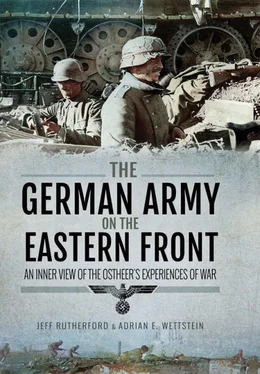F) Giving orders
The immobility of the leaders and their staffs means that rapid decisions during the battle are rarely made and have an effect. The leaders of motorized units trained during the summer in rapid decision-making and the brief giving of commands have to relearn. It is necessary to think through all possibilities of the offensive action with imagination and to weigh up advantages and disadvantages. All leaders must be instructed in detail before the attack begins, if possible on the previous day, about the intended conduct of battle and the expected and possible combat crises. The leaders in charge must know what measures and actions are expected from them in each combat phase.
One important point to make here concerns the quality of the German officer and NCO corps. As previously stated, the German command system required a thoroughly trained and educated leadership to work smoothly. The homogeneity and quality of the German officer corps had decreased significantly in the rearmament period due to the need for thousands of new officers to staff the rapidly expanding armed forces. When the war began, the German army could field some 90,000 officers. Losses in the early campaigns were relatively high, but at the same time, the officer corps gained much combat experience and further time for training. Probably the high point of quality was achieved in the summer months of 1941, before the mass losses of officers and NCOs in the east again decreased the quality. Measures taken, such as field training for leaders, did not stop this trend, but considerably slowed it until summer 1944, when the German army began to collapse due to the Allied double strike in Normandy and Belarus. While this is a general observation, there were great differences between theatres and units, depending on combat intensity, periods of refreshment, and, of course, unit leadership interest in training and educating leaders.
The following document is a collection of guidelines for training based on combat experiences from mid-1942. While giving an idea about leadership training issues, it also reveals deficiencies in the German low-level leadership. [7]
1) With the broad front sectors and vastness of the Ostraum , every leader must be educated to fight independently, to secure his flank and rear, and to fulfil his combat mission in the sense of the whole. A much more flexible training of the entire low-level leadership is therefore necessary. […]
3) The great carelessness, which manifests itself in the advance in concentrated clusters, in reckless movements at open points, lack of camouflage, rattling with equipment, loud chattering, etc., must be combated again and again, especially by the responsible leaders.
There is a need to put more emphasis on this – this is mainly the responsibility of the company commander – that the troops on the battlefield are not concentrated but moving in open order. If breaks occur, every man must necessarily take cover or lie down. Everything must be done to ensure that unnecessary losses are not caused by negligence and a certain amount of herd instinct.
Particularly the officer must here act as an example through warlike behaviour, coupled with a willingness to take responsibility and the drive of his own initiative.
4) […] The young company leaders lack a thorough training in leadership. This defect cannot be replaced by combat experience. Therefore, it is necessary for the company leaders to learn: a) tactical principles on the basis of manuals and based on the experience of the war, b) estimate of the situation and terrain c) formulation of decision and giving of commands, d) cooperation with heavy weapons, artillery and tanks, e) training of leaders for reconnaissance patrols and assault detachments f) organization, armament, equipment and training of reconnaissance patrols and assault detachments. […]
5) It has repeatedly been shown that the mass of officers and NCOs is not able to train properly when units are withdrawn for refreshment behind the front. […]
9) In the training of the officers, close combat training (with rifle, pistol, submachine gun, hand grenade and satchel charge), in conjunction with the training of reconnaissance patrols and assault detachments must be more stressed. The leader and subleader must learn to recognize each weakness of the opponent on the battlefield, and be educated to trigger the corresponding counter-measure in a flash-like manner. […]
24) The leader and the NCO must have a certain ability to acquaint themselves quickly with captured weapons and to get the most out of this weapon for battle. The officer must take a certain pleasure in dealing with weapons of all kinds and their capabilities. The officer and the NCO must be able to use all the weapons of his branch. Where there are gaps, they would have to be closed if applicable in combat. In officer training, it must be expressed that it is no shame if even the officer is not familiar with individual weapons, but the greater his effort must be to close such gaps in training. […]
25) The reports on the enemy and the situation must be formulated in such a way as to give a clear picture of the situation to the superior command level. Reports of the enemy must pay more attention to the impression of the enemy that the troops in the front have; therefore a critical assessment of the report and a corresponding forwarding. Education to check out the situation oneself as often as possible.
The directive demanded more care in preventing losses, better training in close combat and weapons handling, and an improvement in clarity and precision of messages. In addition, the order addressed issues typical to the German command system, such as an eye for the situation, independent command, and the will to take responsibility. The stress in point 5 on the general lack of command abilities of young company commanders is quite striking. A sufficient training of the low-level leadership was never fully achieved in the war, and the longer the war endured, the more low-level leaders became simple one-dimensional fighters, who electrified their men on the battlefield, but were not full-fledged leaders in the German sense. They still often matched their opponents in quality, but could not fully reach German leadership standards. This was also recognized by the German army and had organizational consequences, as discussed here in a presentation of Army Group South’s propositions to raise the combat power of the infantry in 1943:
Furthermore, it proved that the company leader was not able to orderly lead a strong company with numerous attached weapons, since he had increasingly transformed from a tactical leader to a standard-bearer as the war progressed. The tactical leadership fell to the battalion commander. Accordingly in some Panzer divisions even organizationally attached medium mortars and heavy machine guns were deployed by the battalion. However, due to the large width [of the company sectors], the machine guns must be again placed at the disposal of the companies in the defence. [8]
The problem was that the losses in the higher ranks made it necessary to promote neither fully-formed nor fully-prepared officers to the battalion and regimental levels. While special courses – including ones for divisional commanders beginning in 1943 – should have helped them, quality nonetheless suffered even with elite units, as a training order from Panzer Grenadier Division ‘ Grossdeutschland ’ in May 1943 reveals:
The proper conduct of combat: battalion commanders, company leaders, platoon leaders must be educated to fight with the most economical use of men and under the maximum use of machines. The favourite scheme of most battalion commanders with 1st company right, 2nd company left, and 3rd company in the centre behind must yield to a more intellectual approach.
Читать дальше






![John Stieber - Against the Odds - Survival on the Russian Front 1944-1945 [2nd Edition]](/books/405234/john-stieber-against-the-odds-survival-on-the-russian-front-1944-1945-2nd-edition-thumb.webp)





